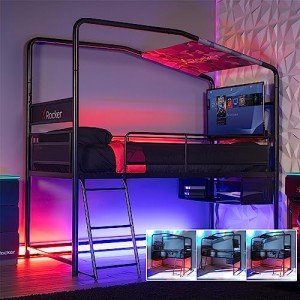Cabin Bed Ladder

The cabin bed ladder is constructed from solid Southern Yellow Pine. It is extremely strong and durable, just like telephone poles.
The bed ladder is clipped to the frame, and you are able to hold the other end, the "ladder" end, by the rungs. The ladder can be placed at either the foot or side of the mattress.
Safety Features
A bed ladder in a cabin should be sturdy and durable to ensure safety. It should be firmly connected to the bed, without gaps, or looseness that could lead children to fall from their beds or fall off the ladder. Many manufacturers offer installation services to ensure the safety and security of your loft or bunk bed. However, it is essential to go through all instructions and safety warnings carefully before attempting DIY installation.
The ladder must be angled correctly. A slight incline on ladders help younger children to reach the top bunk, and are safer for them to climb than traditional vertical ladders. This type of ladder takes up a bit more floor space than a standard ladder for bunk beds, but it is worth the extra space to lower the chance of accidents.
To avoid injury, the ladder should also have smooth surfaces and edges that are rounded. Rounded corners eliminate sharp edges that could catch clothing or catch it. The frames of ladders and steps should be sanded to remove rough materials and eliminate hazards like splinters. Some models include storage drawers that are built into the steps, adding functionality without compromising safety.
A bunk or loft ladder for beds should have guard rails that extend at least 5 inches higher than the mattress's surface to safeguard sleeping people from falls that could happen in the course of play or sleep. Some models come with removable railings for flexibility and adaptability while others have permanent installations to ensure long-term stability.
If your kids are active dreamers or sleepwalkers, a removable Ladder Gate can prevent them from climbing onto the top level at night. A Ladder Protector can keep your children safe from injury when they climb up to the upper level.
Before buying a cabin bed with a ladder, measure the dimensions of your child's room to ensure it has sufficient space for the bed and any additional features that might be connected to it. It's also important to check the ceiling height, especially when you're thinking of a high sleeper model. A loft or bunk bed that is too close the ceiling could block airflow and create discomfort. It could also be a fire hazard and obstruct the windows, resulting in injuries caused by broken glass or falling items.
Length
You want to make sure that the ladder you select is the correct length for your room. You don't need it too tall or too low. For youngsters, it's recommended to keep the rungs about 10 inches apart, and for adults 12 inches apart.
The rungs must also be rounded at the end. Square edges can give the appearance of splinters or rough to the touch. This is especially important if you are building your own bunk bed ladder because it's something you could easily overlook.
The location of the ladder on the bed frame is also important. The most common location is at the foot of the bed, however, you can also fix it to the side of the bed. Both positions have their benefits and drawbacks, so it's up to you to choose which one is best for your bedroom.
Design
A cabin bed ladder is attached to the frame at one end, which is different from traditional ladders that are attached either to the frame or the foot of the mattress. The other end, which has the rungs is held by the person using it. This design allows for more independent movement in bed, which can be especially beneficial for those who have had significant abdominal surgery or who are unable to move around. 4ft cabin bed Bunk Beds Store that a cabin bed ladder is only attached at one end makes it easy to put up and use. This is important, especially in bunk beds for campers where space can be a problem.
